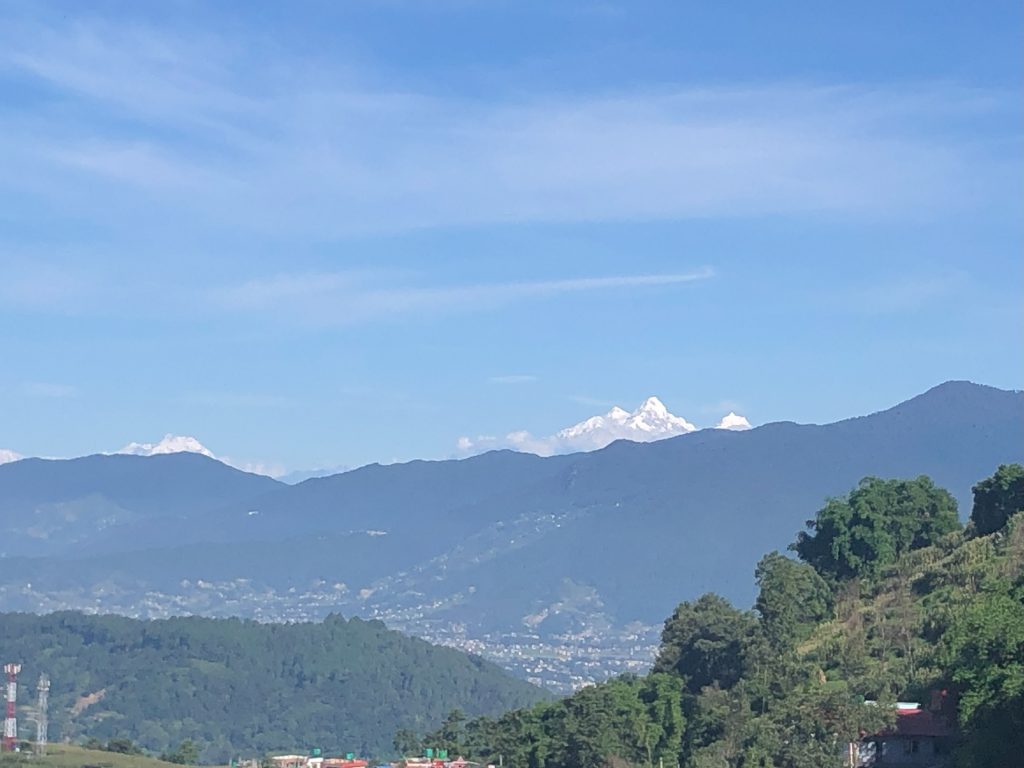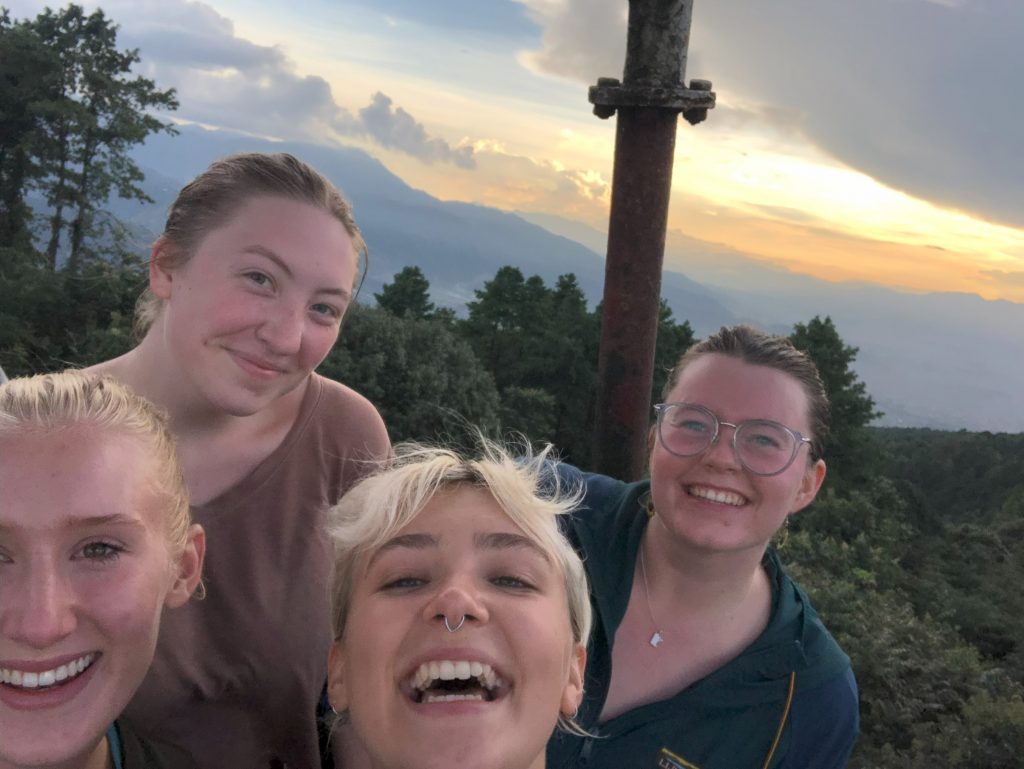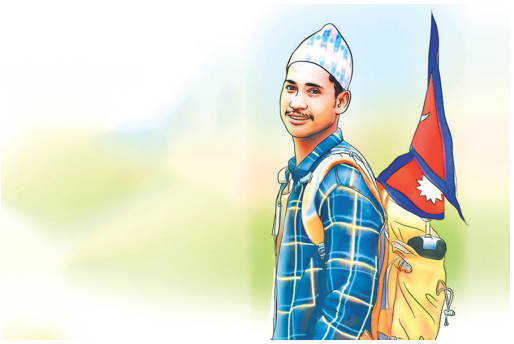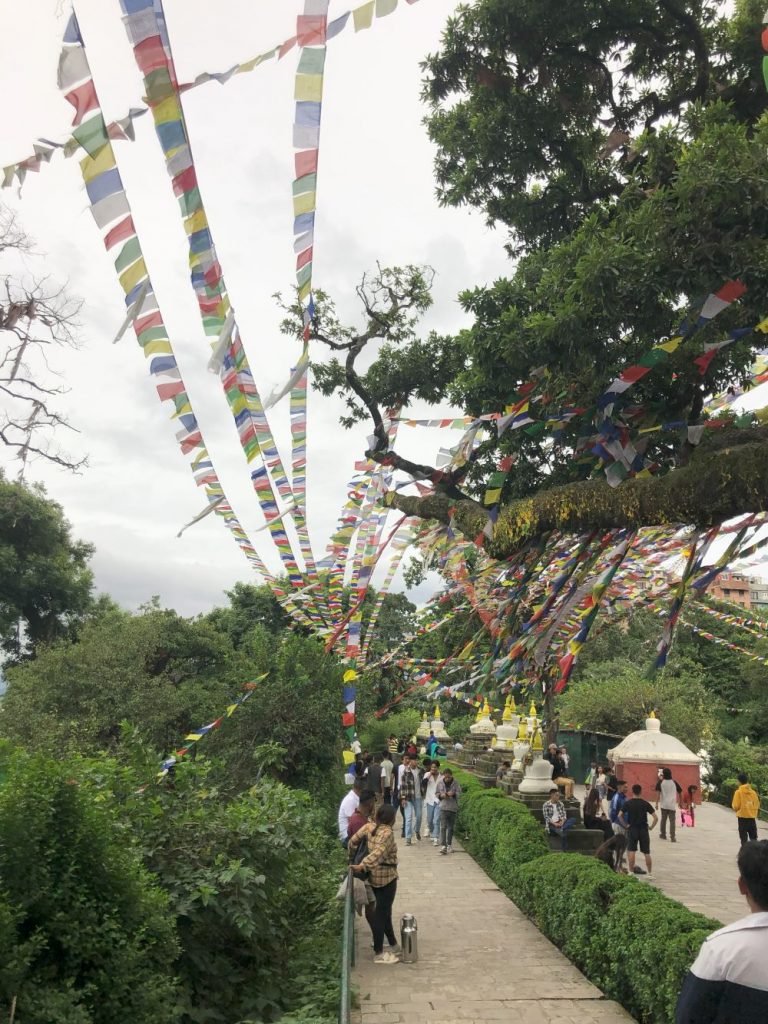Week 1 in Nepal!
The journey began with a bus and ended with a bus. All in all, we totaled ~22 hours of travel from JFK to KTM. Mercifully, our weariness was softened by the unexpected luxury we encountered on both of our Qatar flights- pillows, blankets, movie screens, and ample meals were all greedily consumed when offered. Still, most of us arrived at the Kathmandu airport feeling more dead than alive. There’s just no way to spend that long in transit without succumbing to the looming fatigue! My mood shifted as soon as we stepped out onto the tarmac, however, because I blinked and there they were… right before my eyes the Himalayas stood proudly, welcoming us to their homeland with an air of opulence that only the world’s grandest mountains can give off.

We were all introduced to Yanik, our new country coordinator, who was awaiting our arrival alongside his team – Krishna, Nirvana, and Laboni. They graciously took our luggage, threw it into a very cute and blessedly air-conditioned bus, and we started our hour-long commute to a hotel far up on a hillside overlooking the valley. The hotel acted as our transition space for two nights, before we were picked up by our homestay families.
The bus ride was slow but peaceful. It was mesmerizing to pass by so many houses and shops, occupied and run by people who live their lives in a place that used to exist only in my imagination. Motorcycles scittered behind and directly beside the bus like excited insects, their drivers unafraid to come within mere inches of the vehicles swirling around them. Many of the people we passed waved or nodded at the bus, which surprised me and painted a joyful expression across my face despite my fatigue. When we finally arrived at the hotel, we were provided with a Nepali-Western fusion style dinner to “ease our stomachs into Nepali food,” (Yanik is always looking out for us) and then it was off to our assigned rooms and our long-awaited beds. On the way down the path to my room, I was stopped in my tracks by the expansive view that stretched before me- off the hotel balcony, below the towering hill it was built on, the entire city of Kathmandu twinkled and shone, lit up by thousands of small, multicolored lights. The breadth of the city was astounding- I had no idea how big it would be. My friends and I sat and gazed in awe and laughed and shared our gratitude for being here with one another, and then we all fell into deep, much-needed sleeps.

– – – – – – – – – – – – – – – – – – – – – – – – – – – – – – – –
Our first morning in Nepal was marked by further excitement, marvel, and gratitude. I crept quietly out onto the terrace first thing in the morning to call my boyfriend, and I could not believe how beautiful the valley was in both darkness and light. Great green mountains stretched in a powerful ring around the city, as if guarding it. Blue-gray pigeons hopped between the rooftops and chatted on wires, the noises of morning rituals began to rise from the houses around us, and prayers were loudly being broadcast from a nearby temple. The most dramatic of the views, however, was that of Ana Purna 2 (initially I misjudged it for Everest, lol) reaching up and scraping the sky from behind a softer, green range. There was a collective moment of exclamation as we all suddenly realized that the sharp white shape behind the other mountains was not, in fact, a cloud, but an epic mountain in its own right. I sat outside and stared at the mountain as long as I could- It’s knife’s-edge sharpness and towering height captivated me, topping off the list of epic mountains that I had seen this year (the Appalachian, the Sierra Nevada, and now the Himalaya?! PLEASE!).

Eventually, Krishna came down to wish us all good morning and to enjoy the view, too. He said that this was the first time in four years that Ana Purna 2 was visible from this hotel while SIT students were there- usually, the dust and the air pollution from the city, or bad weather, veiled the mountain’s full majesty. He explained that most of the Kathmandu valley was comprised of commercialized land, which is why we saw tiny houses perched high upon most of the hills around us. The hill our hotel was located on, however, was part of a national park and was thus protected by the Nepali government. Sure enough, we saw a long line of soldiers trudging up the street with big packs and big guns later that morning, conditioning themselves and checking in on things as per army requirements.
Our day in the classroom was filled with exciting and important orientation information relayed to us by Yanik and his team, E-SIM and SIM card distribution, and a fascinating lecture on the nation’s history and governmental goals, given to us by Anil- an environmental engineer who has been a part of numerous renewable energy initiatives in Nepal over the last 3 decades. I learned that Nepal’s gov’t has been transformed many times, but always from within- It was never colonized by outside forces, meaning that much of Nepal’s ancient historical sites and it’s indigenous cultural traditions have been better preserved than those of China or India. Additionally, Nepal’s current democratic republic has placed extreme value on two things: inclusion, and resilience. The current Nepali administration has set an honorable goal to include all members of society in society- one way they’ve made strides towards this goal is by including braille numbers on their coins, making Nepal the first country in the world to do so. That said, the rights of women and children are still extremely limited, which means that all Nepalis are still not equally included in society.
After our lecture, Krishna led interested parties on an “easy” hike up to the top of the hill/mountain our hotel was located on. We began walking straight up a very steeply graded, winding road and Krishna quickly asserted his place at the front of the pack. I was amazed by how fast he moved up such brutally steep terrain, and when I told him so, he laughed and said, “When I was training for the army, I had to run up this road! Walking is much easier.” I laughed too, deeply humbled. After about 10 minutes, we were all passed by Yanik on his motorcycle with Dr. Glaser at his back. She laughed and did a queenly wave as they flew by… faculty privileges, I suppose! When we finally reached the top, the rusted tower stood proudly, beckoning us to climb its many steel rungs. The view from the tower was beautiful- a soft breeze cooled our sweaty bodies as we watched the sun sink low and paint the many different mountain ranges with color. We spoke to a man on the tower who was a 75 year-old doctor (he looked maybe 55), who told us about the virtues of daily exercise and giving up gluten. I smiled, nodded, and dreamed of momos and soba pudding. Haha!

– – – – – – – – – – – – – – – – – – – – – – – – – – – – – – – –
The remaining days flew by in a total blur of close calls with motorcycles, busy streets full of people and dogs, long but fascinating lectures, approximately 20 academic articles that demanded reading, the beginning and end of a research proposal, and lots of Dhal Bhat. We were formally introduced to Kathmandu by being thrust out into the entopic streets with our host mom, who mercifully walked us to school the first morning. I was AMAZED that we made it all the way there- and all the way back that afternoon- without witnessing multiple traffic-related fatalities. Motorcycles careened through the unbelievably narrow, winding maze of alleys in Patan, brushing by us with loud honks and mere inches to spare. Stray dogs napped in small patches of shade under parked cars, seemingly unbothered by the swarm of wheels whirring by and the cacophony of traffic noises. Faces appeared through the open storefronts along the street- men pounding metal, mannequins draped in rich magenta fabric teetering on the steps, women sorting bloody meat in butcher shops, children squinting and laughing among buckets and tables full of fruits and vegetables.
Starting the first morning that we spent in Nepal, my peers and I began receiving a host of lectures and presentations that served as a crash course in the Nepali government and it’s controversial agenda for rapid development across the nation, the economy, the nation’s history, the indigenous tribes in various regions, the prevailing realities of caste-based discrimination, and the major religions of Nepal (Buddhism, Hinduism, and many that blend in between). We had many notable presenters come into our classroom space who are involved with different facets of Nepali society- pre-law students from the Dalit community (Dalits are the community at the bottom of the caste system who have historically faced the most discrimination in Nepal, and continue to endure inhumane treatment today) who are determined to defend the rights of their friends and families, professors from local colleges, and many more.
We learned that there are 70+ political parties in Nepal, each of which fall into one or more of the following categories: Democratic, Communist, Socialist, Regressive, Identity, and/or Revolutionary. 6 parties from a variety of these categories come together to run the Nepali government under the president and prime minister (they have both!). Overall, around 60% of Nepalis support communist-based parties, but many of these parties are not truly communist in their practices. It’s very complicated and frankly I’m still fuzzy on a lot of this.
We also learned about the economic struggles and triumphs of the Nepali people. In rural areas, agriculture is the overwhelming source of income for most families- Dalits, however, face structural barriers to owning land, which means that it’s extremely hard to find work in rural areas (and in many urban ones, too). Hydroelectric power has become a huge industry in Nepal in the past few decades because of the abundant rainfall that Nepal receives during the monsoon season. Electricity is exported and sold to many of Nepal’s neighboring countries. This has been complicated by global warming and the disparate effects that climate change has had on Nepal in particular, though. Nowadays, the summers are hotter, the rainy season may be shorter or arrive later than normal, the majestic Himalayan peaks are coated with black soot and dust from the metropolitan areas in the valley, and both dust and smog smudge out the cities skies during long periods without rain. Seeing the haze in the air is very sad, and apparently the average Nepali loses three years of life simply by breathing in this air every day. In some areas of Nepal, people can lose up to five years. Climate justice is a huge issue here, and many people are fighting to make the government understand how dire the situation is- sound familiar?
We also took a class that focused on the different regionalities, traditions, and struggles that Nepal’s indigenous groups face. Many of our homestay families are from the Newar community- the indigenous community that were the original inhabitants of Kathmandu Valley. For the past week, my host mom has generously prepared lots of Newari cuisine for me to try, which has been delicious! Lots of earthy flavors from the frequent use of lentils and rice along with smoky and tangy flavors from the rainbow of spices she uses. My host sister Sonya is awesome- she is a journalist here in Patan, and she has been working for the Nepali times for eight years! She is smart as a whip and knows all about the complexities of politics, social norms, religion, and climate justice in Nepal. I love talking to her about the things I see on my walks to and from school, and about what we discuss in our lectures. When I came home one day after spending the afternoon learning about and discussing the caste system and the violence that it has created in Nepal (which is still very real- in 2020, a young boy from the Dalit community named Nabaraj BK and six of his close friends, also Dalits, were murdered and thrown into the Bheri river because Nabaraj had fallen in love with a girl from a higher caste. He and his friends were murdered while escorting Nabaraj to her house so that he could propose to her.), Sonya was able to help me process the intense emotions that I was feeling and informed me about her own experiences with caste in Nepal. Sonya made space for my sadness and allowed me to empathize with her, which helped me feel more grounded after such an intense day.

Sonya’s parents- my host parents- do not speak very much English, which has been a difficult but surprisingly rewarding experience for me. I communicate with them through excited, joyful hand gestures and eye contact much of the time, and my theatrics always seem to make them smile. One night this past week, my homestay pair Amelia and I decided that we were going to try to eat dinner the Nepali way- no utensils, just using our right hand. Dinner was rice, yellow dhal, and roasted Okra, and when our host mom saw us committedly fumbling to gather rice with our hands she shrieked with glee. She said, “Yay!! You eat with your hands!” and began clapping. In those moments, body language speaks loudly and clearly and the presence of joy is a tangible substance in the room.
On Thursday, our class split into two groups for site visits to local LGBTQ-focused NGOs. My group visited Mitini, Nepal- an NGO working for the rights and dignity of LBT women since 2005. The org was founded by a lesbian couple whose life experiences had informed them of the yawning gap in social services available to LBT women in Nepal. Since 2005, they have become deeply involved in changing and creating legislation in Nepal to protect and serve the LGBTQ+ population, and they have offered a holistic range of resources (legal aid, a community kitchen, career skills workshops, English lessons, financial literacy, etc.) to the community they serve. Mitini and other LGBTQ+ advocacy groups have made awesome strides in the fight for equality over the past few decades, such as when same-sex marriage became provisionally legalized on April 24 of THIS YEAR (!!!) but the journey has really only just begun. At this point, a vast majority of Queer Nepalese youth who come out to their families are shunned and forced out of their houses, leading to homelessness, poverty, and other violations of their basic human rights. Our speaker at Mitini told us, “Being openly Queer in Nepal is about the most difficult thing you can be, especially at intersections of caste, gender, and ability.” Our group ended up speaking with the Mitini team for almost four hours over butter tea and biscuits, asking questions and sharing our various American perspectives. Before we left, they gave us handfuls of small stickers with their logo cast upon a progress pride flag, which have found themselves all over Kathmandu and Patan since. <3

During our blessed and restful day off on Saturday, myself and a few others decided to embark on a journey to Swoyambhu Mahachaitya- the most important Buddhist temple in Nepal, also known colloquially and by tourists as “the monkey temple”. They were free-range and all over the place!

The temple atmosphere was incredible. Stray dogs, monkeys, pigeons, and crows made up a fascinatingly unexpected ecosystem all around us as we wandered through the ancient statues of Buddhist idols and along rows of mani wheels inscribed with names and Buddhist mantras. Countless layers of criss-crossing Lungta flags fluttered above us between trees and from the pinnacles of buildings, creating a colorful patchwork sky. While the monkeys and the statues and the sounds of Buddhist prayer rituals were fascinating, my favorite part about being there was learning about the significance of the Lotus flower in Buddhism. Most statues and images of Buddha feature him sitting on a Lotus throne- a sign that he has achieved true enlightenment and has let go of all his material and vain human attachments. The lotus acts as a reminder of the discrepancy between function and form- we should appreciate the flower for it’s function (as a pollinator, as an indicator of health and growth) rather than it’s form, because eventually the flower will die and give way to a new phase of life for the Lotus plant. One of our lecturers explained it like this- If he were to buy a fancy watch to tell him the time, when he inevitably loses or breaks the watch he will be very sad. But if he values watches based on their function rather than their form, he will be able to replace any watch he breaks or loses without grief- he will only feel gratitude for being able to restore his sense of time.
This was such a striking idea to me, and it caused me to reflect deeply on my own insecurities and on the things that I place external value on. Every day I stand in front of the mirror and put on makeup to cover up my blemishes and the dark shadows under my eyes, so that I look as close to “perfect” as I can. I do this even when I am exhausted, when I am running late, when I am overwhelmed and when I don’t feel like doing it. By behaving this way, I am placing more value on the “form” of my skin, of my face and body, than on it’s function- to protect my insides from the elements, to allow me to see, hear, smell, speak, and create facial expressions to communicate to others. To cry, to feel the breeze, to taste delicious foods and to think deep thoughts. Buddhism is profound and I feel so lucky to be in a country where it surrounds me every day- where idols and mantras watch over me as I walk through the insane traffic patterns on my way to school and in the prayers of my host mom that I hear through the walls each morning and night. Oh Nepal! You are so many things and people all at once!


September 15, 2024
Comments are closed.